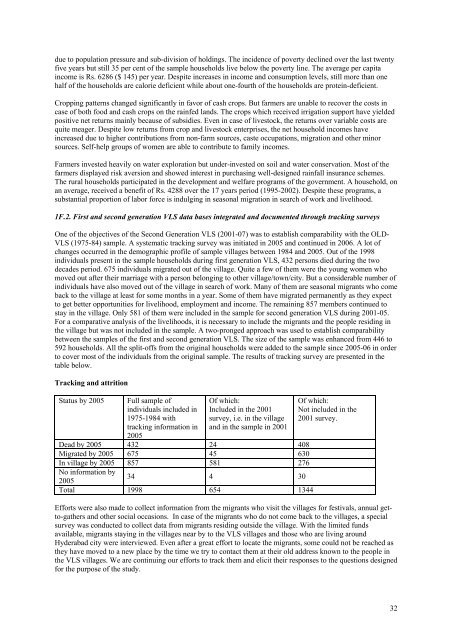ICRISAT Archival Report 2006 - The seedlings of success in the ...
ICRISAT Archival Report 2006 - The seedlings of success in the ...
ICRISAT Archival Report 2006 - The seedlings of success in the ...
You also want an ePaper? Increase the reach of your titles
YUMPU automatically turns print PDFs into web optimized ePapers that Google loves.
due to population pressure and sub-division <strong>of</strong> hold<strong>in</strong>gs. <strong>The</strong> <strong>in</strong>cidence <strong>of</strong> poverty decl<strong>in</strong>ed over <strong>the</strong> last twenty<br />
five years but still 35 per cent <strong>of</strong> <strong>the</strong> sample households live below <strong>the</strong> poverty l<strong>in</strong>e. <strong>The</strong> average per capita<br />
<strong>in</strong>come is Rs. 6286 ($ 145) per year. Despite <strong>in</strong>creases <strong>in</strong> <strong>in</strong>come and consumption levels, still more than one<br />
half <strong>of</strong> <strong>the</strong> households are calorie deficient while about one-fourth <strong>of</strong> <strong>the</strong> households are prote<strong>in</strong>-deficient.<br />
Cropp<strong>in</strong>g patterns changed significantly <strong>in</strong> favor <strong>of</strong> cash crops. But farmers are unable to recover <strong>the</strong> costs <strong>in</strong><br />
case <strong>of</strong> both food and cash crops on <strong>the</strong> ra<strong>in</strong>fed lands. <strong>The</strong> crops which received irrigation support have yielded<br />
positive net returns ma<strong>in</strong>ly because <strong>of</strong> subsidies. Even <strong>in</strong> case <strong>of</strong> livestock, <strong>the</strong> returns over variable costs are<br />
quite meager. Despite low returns from crop and livestock enterprises, <strong>the</strong> net household <strong>in</strong>comes have<br />
<strong>in</strong>creased due to higher contributions from non-farm sources, caste occupations, migration and o<strong>the</strong>r m<strong>in</strong>or<br />
sources. Self-help groups <strong>of</strong> women are able to contribute to family <strong>in</strong>comes.<br />
Farmers <strong>in</strong>vested heavily on water exploration but under-<strong>in</strong>vested on soil and water conservation. Most <strong>of</strong> <strong>the</strong><br />
farmers displayed risk aversion and showed <strong>in</strong>terest <strong>in</strong> purchas<strong>in</strong>g well-designed ra<strong>in</strong>fall <strong>in</strong>surance schemes.<br />
<strong>The</strong> rural households participated <strong>in</strong> <strong>the</strong> development and welfare programs <strong>of</strong> <strong>the</strong> government. A household, on<br />
an average, received a benefit <strong>of</strong> Rs. 4288 over <strong>the</strong> 17 years period (1995-2002). Despite <strong>the</strong>se programs, a<br />
substantial proportion <strong>of</strong> labor force is <strong>in</strong>dulg<strong>in</strong>g <strong>in</strong> seasonal migration <strong>in</strong> search <strong>of</strong> work and livelihood.<br />
1F.2. First and second generation VLS data bases <strong>in</strong>tegrated and documented through track<strong>in</strong>g surveys<br />
One <strong>of</strong> <strong>the</strong> objectives <strong>of</strong> <strong>the</strong> Second Generation VLS (2001-07) was to establish comparability with <strong>the</strong> OLD-<br />
VLS (1975-84) sample. A systematic track<strong>in</strong>g survey was <strong>in</strong>itiated <strong>in</strong> 2005 and cont<strong>in</strong>ued <strong>in</strong> <strong>2006</strong>. A lot <strong>of</strong><br />
changes occurred <strong>in</strong> <strong>the</strong> demographic pr<strong>of</strong>ile <strong>of</strong> sample villages between 1984 and 2005. Out <strong>of</strong> <strong>the</strong> 1998<br />
<strong>in</strong>dividuals present <strong>in</strong> <strong>the</strong> sample households dur<strong>in</strong>g first generation VLS, 432 persons died dur<strong>in</strong>g <strong>the</strong> two<br />
decades period. 675 <strong>in</strong>dividuals migrated out <strong>of</strong> <strong>the</strong> village. Quite a few <strong>of</strong> <strong>the</strong>m were <strong>the</strong> young women who<br />
moved out after <strong>the</strong>ir marriage with a person belong<strong>in</strong>g to o<strong>the</strong>r village/town/city. But a considerable number <strong>of</strong><br />
<strong>in</strong>dividuals have also moved out <strong>of</strong> <strong>the</strong> village <strong>in</strong> search <strong>of</strong> work. Many <strong>of</strong> <strong>the</strong>m are seasonal migrants who come<br />
back to <strong>the</strong> village at least for some months <strong>in</strong> a year. Some <strong>of</strong> <strong>the</strong>m have migrated permanently as <strong>the</strong>y expect<br />
to get better opportunities for livelihood, employment and <strong>in</strong>come. <strong>The</strong> rema<strong>in</strong><strong>in</strong>g 857 members cont<strong>in</strong>ued to<br />
stay <strong>in</strong> <strong>the</strong> village. Only 581 <strong>of</strong> <strong>the</strong>m were <strong>in</strong>cluded <strong>in</strong> <strong>the</strong> sample for second generation VLS dur<strong>in</strong>g 2001-05.<br />
For a comparative analysis <strong>of</strong> <strong>the</strong> livelihoods, it is necessary to <strong>in</strong>clude <strong>the</strong> migrants and <strong>the</strong> people resid<strong>in</strong>g <strong>in</strong><br />
<strong>the</strong> village but was not <strong>in</strong>cluded <strong>in</strong> <strong>the</strong> sample. A two-pronged approach was used to establish comparability<br />
between <strong>the</strong> samples <strong>of</strong> <strong>the</strong> first and second generation VLS. <strong>The</strong> size <strong>of</strong> <strong>the</strong> sample was enhanced from 446 to<br />
592 households. All <strong>the</strong> split-<strong>of</strong>fs from <strong>the</strong> orig<strong>in</strong>al households were added to <strong>the</strong> sample s<strong>in</strong>ce 2005-06 <strong>in</strong> order<br />
to cover most <strong>of</strong> <strong>the</strong> <strong>in</strong>dividuals from <strong>the</strong> orig<strong>in</strong>al sample. <strong>The</strong> results <strong>of</strong> track<strong>in</strong>g survey are presented <strong>in</strong> <strong>the</strong><br />
table below.<br />
Track<strong>in</strong>g and attrition<br />
Status by 2005<br />
Full sample <strong>of</strong><br />
<strong>in</strong>dividuals <strong>in</strong>cluded <strong>in</strong><br />
1975-1984 with<br />
track<strong>in</strong>g <strong>in</strong>formation <strong>in</strong><br />
2005<br />
Of which:<br />
Included <strong>in</strong> <strong>the</strong> 2001<br />
survey, i.e. <strong>in</strong> <strong>the</strong> village<br />
and <strong>in</strong> <strong>the</strong> sample <strong>in</strong> 2001<br />
Dead by 2005 432 24 408<br />
Migrated by 2005 675 45 630<br />
In village by 2005 857 581 276<br />
No <strong>in</strong>formation by<br />
2005<br />
34 4 30<br />
Total 1998 654 1344<br />
Of which:<br />
Not <strong>in</strong>cluded <strong>in</strong> <strong>the</strong><br />
2001 survey.<br />
Efforts were also made to collect <strong>in</strong>formation from <strong>the</strong> migrants who visit <strong>the</strong> villages for festivals, annual getto-ga<strong>the</strong>rs<br />
and o<strong>the</strong>r social occasions. In case <strong>of</strong> <strong>the</strong> migrants who do not come back to <strong>the</strong> villages, a special<br />
survey was conducted to collect data from migrants resid<strong>in</strong>g outside <strong>the</strong> village. With <strong>the</strong> limited funds<br />
available, migrants stay<strong>in</strong>g <strong>in</strong> <strong>the</strong> villages near by to <strong>the</strong> VLS villages and those who are liv<strong>in</strong>g around<br />
Hyderabad city were <strong>in</strong>terviewed. Even after a great effort to locate <strong>the</strong> migrants, some could not be reached as<br />
<strong>the</strong>y have moved to a new place by <strong>the</strong> time we try to contact <strong>the</strong>m at <strong>the</strong>ir old address known to <strong>the</strong> people <strong>in</strong><br />
<strong>the</strong> VLS villages. We are cont<strong>in</strong>u<strong>in</strong>g our efforts to track <strong>the</strong>m and elicit <strong>the</strong>ir responses to <strong>the</strong> questions designed<br />
for <strong>the</strong> purpose <strong>of</strong> <strong>the</strong> study.<br />
32

















